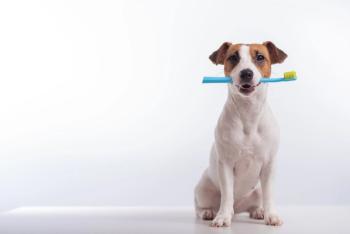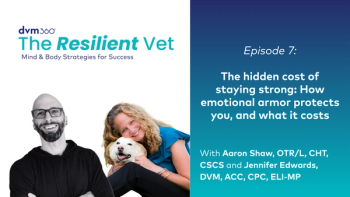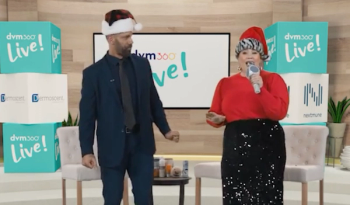
Veterinary Network Focuses on Sea Turtle Conservation
By providing husbandry and health information, an informal network of veterinarians hopes to bolster endangered sea turtle populations around the world.
Dr. Stacy;
credit: Robert Simpson, US Geological Survey
What started 30 years ago as an ad hoc group of marine veterinarians swapping stories at conferences and consulting with one another about sea turtle health has turned into an international network. And now, this network has created the first “sea turtle bible,”
Everyone in the field is a student, said Charles A. Manire, DVM, director of research and rehabilitation at the Loggerhead Marinelife Center in Juno Beach, Florida. He, along with more than 45 professionals actively involved in sea turtle conservation, put their collective knowledge together to co-author the aforementioned book.
“Some of the things [in the book] are applicable across the board, such as parenteral nutrition,” Dr. Manire said. “It’s being used in South America in the rehabilitation of penguin chicks to save their lives.”
Dr. Manire performs surgical debridement to a carapace wound;
credit: Hannah L. Deadman
This total parenteral nutrition formula, which was developed for sea turtles at the Loggerhead Marinelife Center, is an example of how veterinarians are modifying protocols to treat illness in exotic animals. But veterinarians are also using their knowledge to inform policies and regulations designed to enforce compliance with US laws and international treaties.
“When we try to understand the potential human impact, such as from fisheries, on sea turtles, we may not have a lot of formal studies to look to,” Brian Stacy, DVM, PhD, DACVP, a veterinarian for the National Oceanic and Atmosphere Administration Fisheries Office of Protected Resources, said. “But veterinarians who have experience with traumatic injuries in sea turtles or treating [them]…are excellent sources of information that help us understand the effects of activity that we regulate or manage.”
The Next Generation
Dr. Stacy works directly with many of those in the sea turtle network. His responsibilities exist at the meeting point of human and animal interaction in the ocean, so he witnesses firsthand the conflict between human expectations for the environment—a source of livelihood, food, and entertainment—and our responsibility for the animals in it.
Dr. Harms (center) releases a rehabilitated turtle on the coast of North Carolina; credit: NC State Veterinary Medicine
Veterinary schools are incorporating these issues under the umbrella of conservation medicine, which focuses on the relationship between animal health, human interaction, and environmental conditions. Some formalized elements added to the network now include internships and externships, according to Craig Harms, DVM, PhD, DACZM, a professor of aquatic, wildlife, and zoo medicine and the director of marine health programs at North Carolina State University.
Dr. Harms also serves as consulting veterinarian for the volunteer-run Karen Beasley Sea Turtle Rescue and Rehabilitation Center in Surf City, North Carolina. Multiple veterinarians in the region would send sea turtles to the center for care before release to the wild, he said, resulting in a variety of burdensome care guidelines. The staff didn’t always have the time, resources, or expertise to carry out multiple sets of instructions. The volunteers managing the facility decided early on that they wanted the veterinary school to be their primary veterinary service provider to implement some consistency of care, streamlining the protocols, Dr. Harms explained.
Dr. Harms believes Sea Turtle Health and Rehabilitation supports the move toward implementing similar protocols in the field. One example is the “special topics” section, which includes a chapter on field techniques. There are checklists and forms for procedures such as nest excavation.
Sea Turtle Monitoring
When sea turtle nests are accessible to monitors, Georgia state protocol is to remove a single egg for DNA testing. The jobs of nest monitoring and sampling fall under the purview of Jaynie L. Gaskin, MPH, executive director of the Georgia Southern University sea turtle program on St. Catherines Island. She credits the “sea turtle bible” with improving her work.
Dr. Harms; credit: NC State University
“It kind of far out there—how is this rehab and health book going to affect someone who’s on the beach doing nesting conservation with eggs?” Gaskin asked. In particular, she credited the detailed chapter about field collection techniques and sterility for improving her procedures.
“The natural history and biology [are] important day-to-day [for] understanding the reproductive end and learning more about the reproductive cycle,” she continued. “There’s research out there saying that, by relocating to different areas, sometimes we’re biasing the temperature because sea turtles have temperature-dependent sex ratios. Now I teach the interns, ‘think twice before you move the nest.’”
Gaskin is involved with the network, consulting its listserv when she needs suggestions for dealing with predation and responding to requests for information about nest monitoring. She’d like to see a message board accessible to allied professions to expand the interdisciplinary approach to conservation.
Dr. Manire agrees that more involvement is better. “As a veterinarian, I can save a few sea turtles in my hospital,” he said. “But if I can do things that save thousands of turtles all around the world, that has a much bigger impact on the populations, on the conservation effort.”
Margo Pierce is a freelance science writer who’s intensely curious about the planet on which we live. She writes about the natural world because she believes in the power of nature and words to inform, inspire, and connect people.
Newsletter
From exam room tips to practice management insights, get trusted veterinary news delivered straight to your inbox—subscribe to dvm360.




